Passages of Light, Interview with Hilary Jackman and George Criddle
Anna Parlane
Hilary Jackman’s painting practice, which the artist describes as a reflection “on the temporal nature of things and of observation itself”, spans over fifty years. An exhibition of her recent work, Passages of Light, opened on 21 August 2021 at Stockroom Gallery, Kyneton, at eleven o’clock in the morning. Two hours later, regional Victoria entered a snap lockdown. Unable to visit the exhibition in person, I persuaded Jackman together with her fellow studio artist George Criddle to instead submit to an interview. What follows is an edited transcript of our conversation.
The conversation ranges across Jackman’s motivations and methods as well as her experiences of living and working in several different artist communities in and around Melbourne.
As Jackman relates, her youthful impressions of the bohemian artistic community in Eltham during the 1950s and ‘60s were formative. She later had a studio at Eltham’s Montsalvat artist commune and it was also in Eltham that she encountered two worldviews that have deeply shaped her practice: environmentalism and the tonalist painting methods of controversial early-twentieth century artist Max Meldrum. Jackman also discusses establishing Round the Bend, an environmental co-operative in the Bend of Islands where she and her partner, artist Jeph Neale, lived for three decades and worked to conserve the surrounding bushland. Jackman and Neale founded the Artery studio co-operative in Northcote in 2001, where they work within a busy community of artists including co-op member, artist, writer and lecturer George Criddle.
Hilary Jackman: My objective was never to take art into a new realm. It was just to share a vision of things that I value. Following a tradition was important to me. But apart from that, I think it was also, early on, the choice of a lifestyle, and what I found when we moved to Eltham into that art community. Everybody was living an artist’s life. They were building their own houses, making films, writing poetry, working as academics, discussing philosophy. They were all practitioners of some sort, and this was part of their whole lifestyle. Before that I’d been doing illustration, commercial art, which was all cliquey, smart-arse sort of account executives, you know, snapping their fingers. And I thought, “Oh well, this is not for me”.
Anna Parlane: You studied illustration at RMIT in the early 1960s. When did you move to Eltham?
HJ: I was at high school, so about twelve, in the 1950s.
AP: And were you involved with Montsalvat that early?
HJ: Well, at a distance. In those days it wasn’t open to the public, but we got to know part of the circle. Montsalvat was just there like everything else was, Dunmoochin and the potters of Warrandyte. All the teachers at the high school were practising artists. I think all of them were. They were quite happy to talk to me over the back fence, waiting for the bus, about art, about being an artist. It was as though the whole thing was planted as a whole sort of life, encapsulating what you do, how you think about things, who you share with. It was a complete lifestyle, and they were all greenies too. That’s where the environment started to kick in for me, and it has never left. That’s an equal part because it’s contributed a lot to the path I’ve taken.
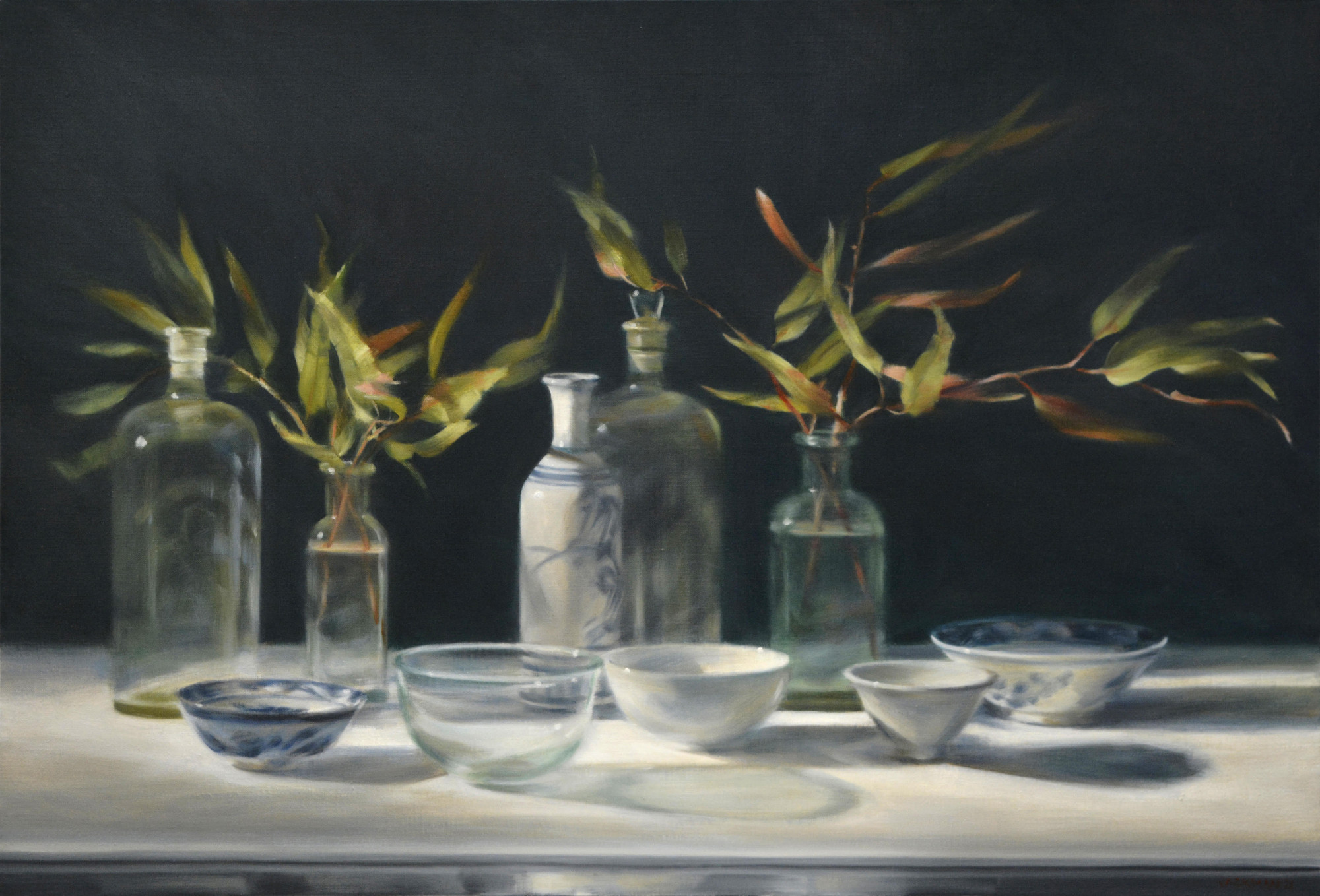
AP: When I decided that I wanted to interview you or write something about your practice, there were two motivations that I’ve come to see as closely connected. One of them was to write about your work, what you produce. And the other was to write about how you live your life. I think that people look at your paintings and they don’t really understand the whole context that they come from. But it seems to me that this kind of collectivist and community-oriented way of living is also a way of working. This is the context out of which your art is produced in lots of different ways. It’s social and artistic, but it’s obviously also financial and political.
HJ: Yeah. It’s got to be a balance. In Eltham, a bit further down the track, I got amongst the tonalist Meldrum students who were still teaching at that time. Alan Martin, Peter Glass, Ron Crawford and peripheral ones like Archie Colquhoun and his students like Shirley Bourne. And there were the Twenty Melbourne Painters, who were a group of mature-aged people, tonal painters. I can remember William Dargie saying, “Look, just forget it guys. You’re wasting your time. You won’t get any interest. You won’t get any support”.
AP: For doing tonalist painting?
HJ: Yeah. And I still look at his work. Some of his early work is just beautiful. His portrait of Namatjira is just such a sensitive, beautiful painting.
AP: When was that? What decade are we talking here?
HJ: This is the 1970s. They were all teaching. They had a teaching structure because they had been taught by a guru. They knew Meldrum was a bit of a guru, so it was all a bit boring. But some of them, like Peter Glass, would say, “Yes, but The Science of Appearances”—that’s the name of Meldrum’s book—“that was his teaching method, but it’s not necessarily what he did himself”.
It’s a teaching method and a very valuable one. But it’s more than that. I’d already had painting classes with Jock Frater, who’s a colourist, as mad as a rat. He’s great. He used to take us on painting trips into the country, and we used to sleep overnight in shearing sheds. Just a mob of artists. But we were always in a mob, somewhere or other we were in a mob. The people in Eltham were a mob. There’s lots of little mobs in a bigger mob. In all the sections of my life, there’s always been a community around me.

AP: I came across an article by Jenni Mitchell called ‘Bohemia in Eltham’. She was describing her upbringing and her experience of being taught tonalist painting by … I can’t remember who it was that taught her—
HJ: Leslie Sinclair, I think. She was at Montsalvat. She was a pupil of Justus Jörgensen.
AP: And Jenni said that when she studied art in high school, it was the 1950s and tonalism was deeply unfashionable. Her art teacher wanted to do modernist abstraction and rapped her over the knuckles for doing this conservative and outdated style. But then tonalism came back in the 1970s when Rosalind Hollinrake discovered all that work by Clarice Beckett.
HJ: Yeah, Rosalind Hollinrake. In the 70s, we formed a group called the Seven Painters, and we were working together all the time. Alan Martin shared his studio with us. David Moore is still painting in Castlemaine; his father was a painter and taught him how to paint. And he was a tonalist. The others were Alan’s students or Shirley Bourne’s students.
But all these teachers, the ones I knew, particularly people like Ron Crawford and Archie Colquhoun and his wife, Amalie—I saw them as old, calm, wise, energetic artists who lived a calm life. It was a charmed life with all these students around supporting them and giving them buoyancy. And I thought, “This is for me. This’ll do. I want to be one of them”.
Neil Douglas was also an influence because he took me into the bush. The Meldrum style had a very European feel, but Neil was very much an environmental bushie, and he took me into the bush and showed me how to look at it. How to think about it in colour and greens, and how to look at the different textures of each species.
But when I went to a Meldrum exhibition at the McClelland Gallery, there was a painting by Clarice Beckett. That turned my life around. That was the first time I’d actually seen a painting that was painted in a way that would capture what I wanted to paint.
I’d been going out into the bush, teaching sixty people on a bus trip, outback. We’d go up to Mutawintji near Broken Hill and set up camp for two weeks, and just paint. It was wonderful. I used a nappy bucket, with the lid as a palette, and acrylics, on 24 x 30s. I stretched them at night and rolled them up in the morning and stretched another one the next day. But they were quite illustrative. I had no idea what I was doing, in those days. No idea. However, the country was delicious. That magic, bush and rocks, and experiences.
AP: Neil Douglas was one of the key people to set up the Round the Bend co-op, wasn’t he?
HJ: He did initiate it. He got the people together to get it started, but it was the people who put it together. It was Randall Champion who came up with the structure of the co-operative. And this came at the time when we were fighting all the dams, because there was going to be I think three dams built, one on the Yarra, it was called Yarra Brae. The whole community was fighting to stop that dam from happening. Then there was the Watsons Creek dam. What we ended up with was the Sugarloaf dam. We couldn’t stop all of them, but we prevented two.

AP: I want to build a connection between these two ideas: that your practice is so much about perception and that you’re so embedded in community and relationships with other people. And I guess what I’m trying to tease out is how those relationships appear in your work or change your perception, how those other people have helped direct your thinking or shaped the way that you see when you’re painting.
HJ: I think that the thing that they’ve given me is acceptance. At RMIT, when Jeph and I went back to study in 1997, I called my practice redundant. They said, don’t do any of your previous work; you need to follow the class. So, I just put it aside and made it redundant. The artists in Artery have accepted what I do as something that isn’t redundant. I mean, how would you describe it, when people take you seriously? I think that that’s been the most valuable thing.
It wasn’t that many years ago when people would look at realist art and just look away. But they seem to be interested now. They look at it with an open mind. They can see that it has some merit, that it’s got somewhere in its timeline of fifty years, that it’s actually got somewhere.
But tonalism, it sounds stodgy, doesn’t it? It sounds black and white. And grey. If I’m doing a painting, I can mix a colour pretty accurately. But colour doesn’t change anything significantly. I’m not using colour to do something. I’m only representing the colour that is there. I tend to use the tone. I work the tone harder, and it has to be exactly right or the whole thing doesn’t fit into place. I can’t get that pictorial space going unless the tone has that ebb and flow through the work that lets things sit where they need to sit within the pictorial space.
AP: One of the interesting things I discovered recently is that Meldrum’s theory was very influential on Ian Burn, the conceptual artist, and other minimalist and conceptual artists. Meldrum was trying to develop an objective method for recording what the artist was seeing.
HJ: In order. It’s called an order of appearances. But Burn’s got that sensitivity to tone. It’s a closeness. Was it Duchamp who said that something was the difference between a clean and a dirty shirt?
AP: The infrathin.
HJ: When I’m painting, the bits I really like doing are the ones where the tones are so close together that there’s no reason why it should work at all until you just squeeze it out.

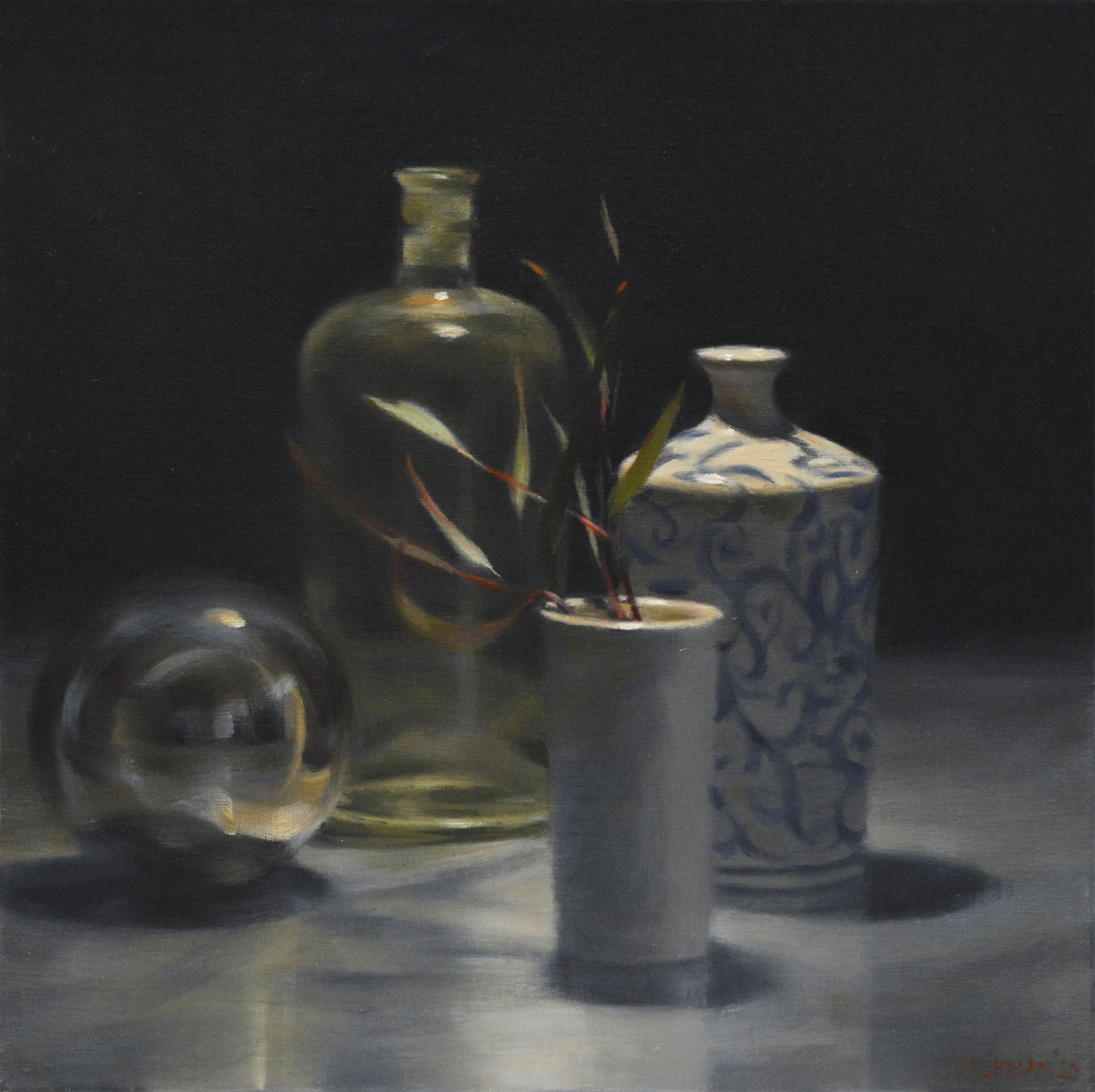
George Criddle: I was just thinking about what you were saying about the community being receptive to your works, Hilary. I’ve always loved coming into your studio at Artery; it’s always been this incredible space where you do the works, and where you’re looking at the objects on the table, and then looking at your painting. I imagine I’m folded into that process too; it’s so attentive and slow. As soon as the pandemic hit, I was like: that studio of yours, I want to be there, and I want to just be looking at your works. I wonder if the pandemic and this heightened sense of attention that we have at the moment calls for tonalism, and that slow, attentive looking that it demands.
HJ: Yes. It knits together, doesn’t it? It’s an isolating thing to be in there painting. I require that quiet time. And yet I never mind an interruption, but it changes the speed when somebody else comes in. The hardest part of my process is setting up something to paint, and that’s where I’ve found the less I think about what I’m doing, the better. I’ve got to get into this zone. It’s like Eduardo Paolozzi, who said it takes a thousand hand movements a day to make an artwork. I move things around, a thousand movements, and just keep looking at what I’ve done. But mostly, I look at what I’ve rejected, because then I’m less self-conscious about what I’m putting together, and I can often find what I need out of what I’ve rejected. I need to creep up on it. Otherwise it becomes mannered or repetitious. I don’t want anything to look like the last one.
AP: One of the things that I’ve always really enjoyed about your studio is that the table where you set up your still life is so theatrical. It looks like a stage set. You’ve got your lights and your fabric draped across it. There’s a lot of dramaturgy in the way you set it up.
HJ: And it’s choreography, what I do with the objects. It’s like making them dance until they have a rest. Mind you, I don’t look at it in detail. I do that Meldrum thing of looking with half-closed eyes. That’s my way of seeing, like seeing a landscape, you cut off a tiny bit and you just paint that bit. I can remember going out with a poet, and he wrote a poem about the day he was watching me paint. He wrote about how many things I missed that were going on in the world around me, and which I never noticed because I was watching this tiny little area for four hours.
The world goes on, and you’re so focused you only see that bit. But once you start looking, it’s not the same. The first hour is not the same as the second. The second day is not the same as the third. It just progresses as you go through the work. You continually see little nuances that you can build on. But I don’t see it all at the beginning, at all. In fact, I don’t even try to. That’s the joy of it, to discover it as you work.

GC: A lot of your objects, Hilary, hold light in ways that are really different. They’re sometimes transparent, or sometimes they have a glaze on them. It’s almost like the combination of objects and how they occupy the space of light, and what they throw into shade or shadow, becomes part of that play of perception. There are these lovely pings of tiny, tiny bits of light that just grab your attention and make you spend a few minutes looking at this one part of the painting.
HJ: The materiality of the objects is very important, how it responds, and how you get glass to be hard when you’ve done a soft, soft painting. How do you make it feel crisp and hard?
AP: A lot of your glasses look like they’re in the process of evaporating. I agree with George, the paintings have these ebbs and flows in them, where things take on and lose solidity as the light moves through them and around them.
HJ: Getting back to Clarice Beckett, and the other one is Whistler’s Nocturnes—I’m just riveted by those simple, beautifully handled, subtle compositions with the most beautiful edges. The edges become so important, because there’s only a few there. You’ve got to be really careful with them. Glass is probably the closest thing I can get to painting mist or an evening landscape where things are already very reduced. I think that’s the only place I get a chance to practice what I really would love to do, which I’ve never done yet. I’ve never done what I really would like to do.
AP: Misty landscapes?
HJ: It fits into the landscape. I can’t go out there anymore, it’s just too physically hard. I remember James Meldrum at RMIT in the 1960s, who gave a lecture, the only one I can remember of the whole four years, when he described what it was like to control the eye traveling over the surface of a painting. And that was so instructive: how you can speed up and slow down by texture and edges. You can bump into an edge and travel along that edge until you lose it, like those passages of light again. You slip through that edge and pick up another edge, and then you run with it. And if it’s too smooth, you just slip across and fall off the edge of the painting. I’m often accused of putting miles too many things in my paintings. But it disturbs the space for me, gives me something to work with.

AP: I think George wrote a beautiful line in the introduction to your exhibition catalogue, which is that your paintings allow us the pleasure of being transfixed. One of the great pleasures of your work is that it forces you to slow down. You can’t see it unless you slow down and allow your eye to be led in the way that you’re describing. It really does have a pace to it.
GC: And a rhythm.
AP: And as a viewer, you’re obliged to see in a different way than you normally would. Do you mind talking, George, about the process that you and Hilary went through for the show at Stockroom?
GC: I was just thinking about how different spaces within Artery have been fruitful for different reasons. The common room upstairs where we gather for lunch and chat about work in progress feels like a very communal space. And then there’s the studio where Hilary’s working all the time. “Where’s Hilary?” “She’s in her studio”. The work’s getting done there with this level of independence and autonomy.
And then there’s the project space where you and I gathered the work you’d done, Hilary, and we started playing with arrangements. You’ll often create pairs of works of the same subject, and we found that if we put these works together suddenly it changed the whole reading of the work from being individual paintings to being a process that happens in the studio.
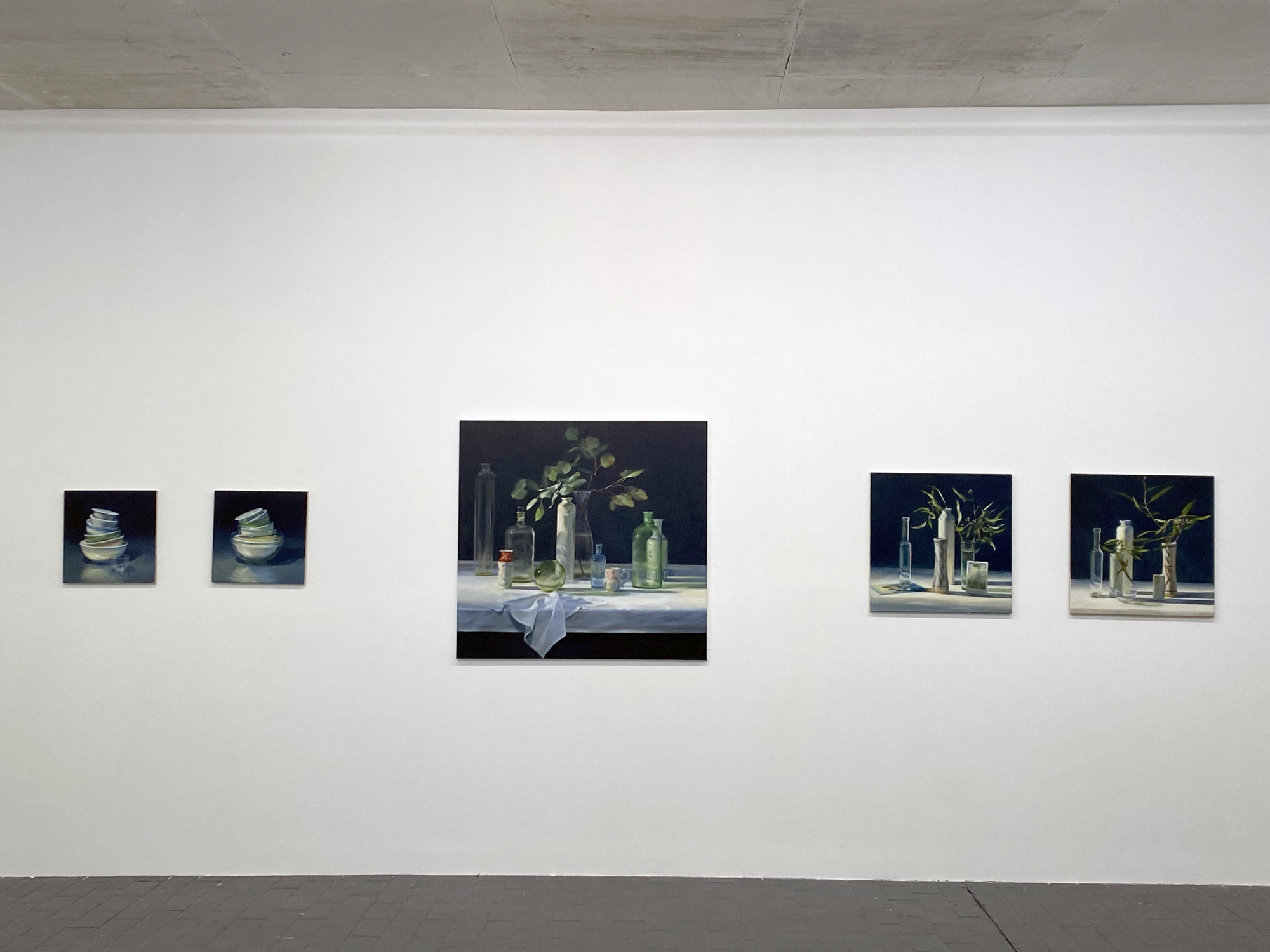
HJ: Now that I’m at Artery, my audience is much more discerning and it opens up these things. It’s an environment that contributes to the way you look at things or how you might set something up.
AP: I think exhibiting the paintings as pairs or small series expands that way of seeing that we were talking about before, where there’s a pace and a rhythm to the way your eye travels across the surface of the painting. Having the paintings next to each other, you can see that perception unfold across more than one painting. You start to see it across the practice.
HJ: It would be nice if viewers retained that memory when they take a work home, because the life of these paintings is not an exhibition. They don’t land until they’re in a domestic environment. I remember going to a John Nixon show, and then later seeing one of the paintings on a friend’s wall. It’s just a little orange square, but what you bring to looking at it is the exhibition you saw, the whole room of them. It’d be nice to think that each painting carries that memory of the whole body of work. It’s not an ambition I would have thought of without the experience of this show.
GC: It certainly does that for me. I’m looking at one of your paintings now, and I do feel like this contemplative space sort of comes out of the painting and starts to inflect the way I look at other objects.
HJ: Well, that was the original goal in painting landscapes. If I did a painting at low tide on the beach, somebody would buy it and say, “That reminds me of … ”, because that’s a special moment for them and they would relate to that particular image. But I wanted people to expand that, to see and value the whole environment because it was being devastated—to make people aware of what they were looking at, just ordinary things, not posh things, special things or the prettiest flower. Do you understand what I’m saying? It’s like sharing the magic of being able to see. Looking at a landscape for six hours or at a still life for a month is indulgent but I think that if I can affect people’s values and how they look at the natural world, I would be … which is hard with a pot and a gum leaf, but there you go.
AP: I never thought of your paintings as landscapes before, Hilary, but now I’m realising that perhaps they are.
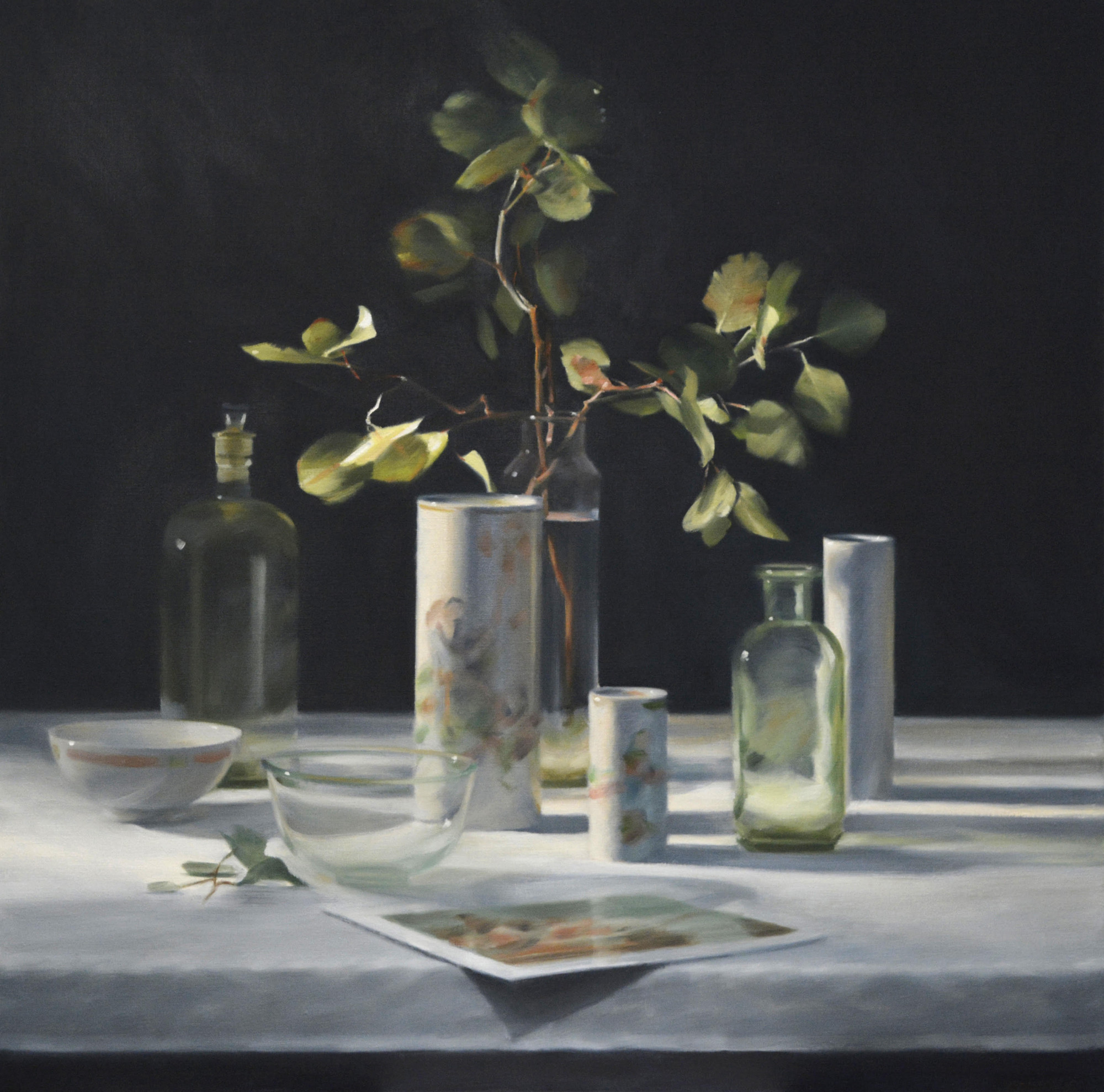
HJ: They’re so influenced by landscape. When you are painting a landscape, you’ve often got twenty minutes to paint it, and it is moving. Shadows move, everything moves, and there’s got to be a certain element of animation in it, a freshness, and you just don’t have time to do anything else anyway. I want to retain that, so it feels like you could move something within the painting. It’s not rendered to a point where it’s become concrete. It’s there but it could be gone any minute. The light could change, and it could be gone.
GC: And maybe this relates to the kinds of objects that you paint. They’re not, as you say, posh, but you’re also painting the same objects over and over again. This arrangement at this particular time has been chosen to be kind of marked and there’s something beautiful about that, as well.
HJ: The artist, when I think of still life, would be Chardin because, again, he does the table. It’s always horizontal. It doesn’t go off at a funny angle or do anything stroppy, and his subjects have always got that sort of humble thing. There’s a jug he used repeatedly; it was a paintable jug. It was a really paintable jug and that’s a very special thing. Finding these objects over the fifty years—there’s been a few of them I borrowed about fifty years ago.
AP: I think that now counts as stolen, Hilary.
HJ: They’re absolutely stolen. When your eyes light on these things, you go, “Yes”. It doesn’t happen very often. There are some limitations I’m quite happy to endure and one is using the same objects. I don’t need to go out and find new objects all the time. It would drive me nuts. It makes it too much to choose from. Getting back to the landscape, I mean, there’s always going to be trees and hills in the background and something in the mid-ground so it’s a consistent thing. And I suppose I choose the still life objects to stand in for those things. But there’s also a time in every work when the image claims a life of its own and starts to demand what is needed to be an independent painting free of its source.
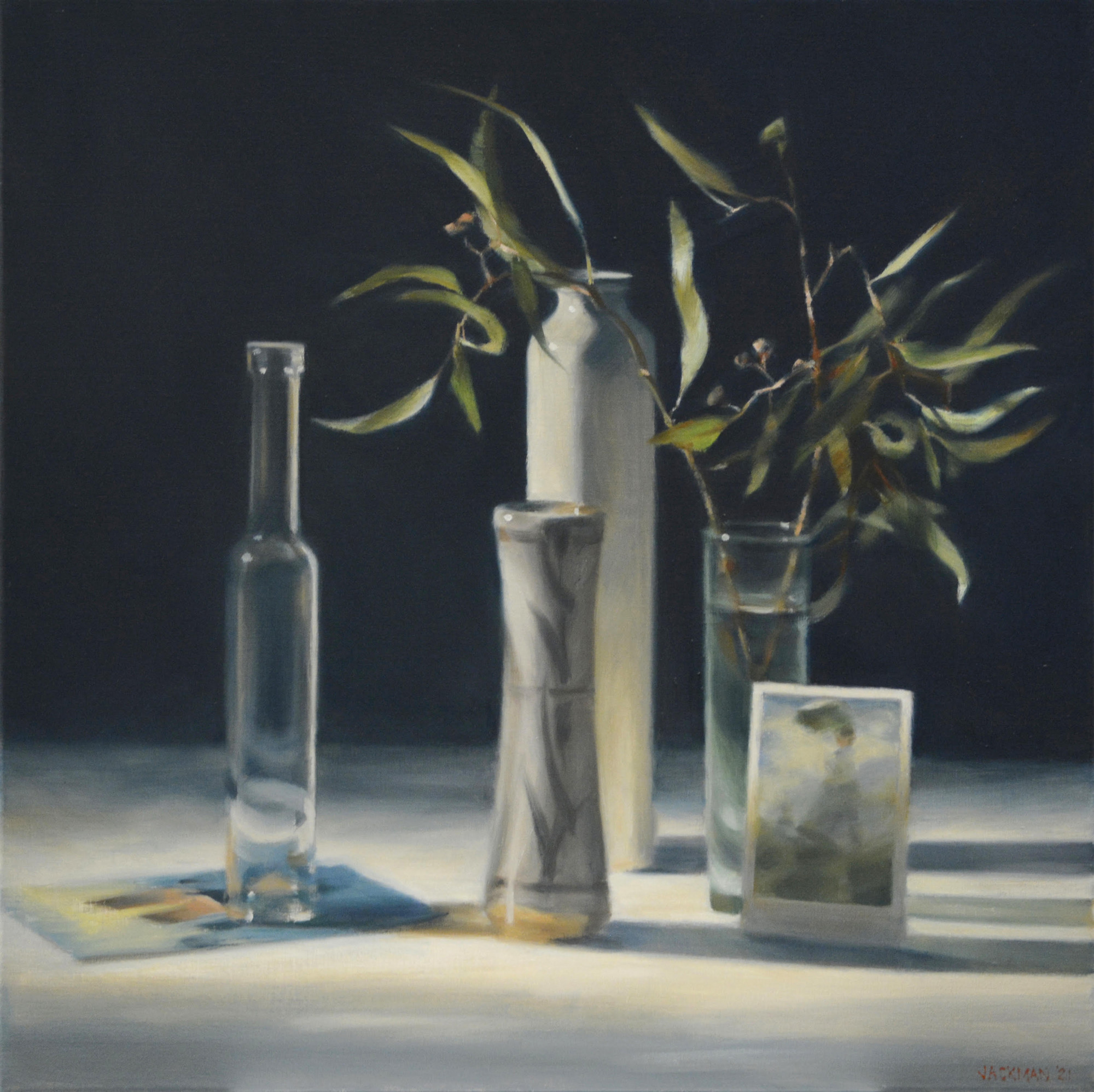

AP: Going back to what you were saying about the artist communities you’ve been part of, shared conversations and shared ideas and different ways of looking at what you’re working on, it strikes me that there are some pretty interesting connections between your practice, Hilary, and others at Artery. For example, George’s recent thinking about perception, the way that mentalities we’ve inherited shape our world view, and how we make sense of the world. I feel like there are connections there. I also feel like there are connections between your practice and Charlie Sofo’s, and his interest in these very familiar everyday objects. He kind of loves them in the way that you love yours.
HJ: Exactly. The way Charlie walks the streets is exactly the way I set up a painting. I still feel that there’s something else I could do. I wonder whether maybe I should get cataracts and that way I’d have a misty view and I’d find it much easier to limit what I put into things so I can get back to really what I’d like to do.
AP: I remember you and I had a conversation about how your eyesight is changing with age.
HJ: I seem to be needing more care at a time when my hand coordination is falling away. I used to be so sure. And the eye is not as reliable. I can remember Lyndal Jones in the sculpture department at RMIT: “Use your body, Hilary. Use your body”. She was into some type of movement therapy. But it is part of it, how you actually move while you’re painting. I move backwards and forwards in the true Meldrum spirit. It is a physical performance in a way, you need to be in a state of togetherness, engaged with the work.
I can remember my very first painting teacher when I was fifteen said, “When you paint a tree, paint it so a bird can fly through it”. It is such a simple lesson on how to look at something. But these are the sort of teachings I’ve had. I’ve had wonderful teachers, really wonderful teachers, and friends.
Anna Parlane is a lecturer in art history and theory at Monash University.


